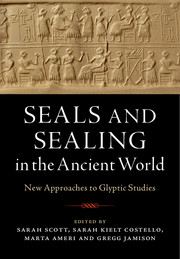 Seals and Sealing in the Ancient World
Seals and Sealing in the Ancient World Book contents
- Seals and Sealing in the Ancient World
- Seals and Sealing in the Ancient World
- Copyright page
- Contents
- Notes on Contributors
- Illustrations
- Plates
- Tables
- Acknowledgments
- Preface
- Abbreviations
- Chapter One Introduction: Small Windows, Wide Views
- Part I The Ancient Near East and Cyprus
- Part II South Asia and the Gulf Region
- Part III Egypt
- Part IV Aegean
- Chapter Eighteen Introductory Remarks, Aegean
- Chapter Nineteen Aegean Bronze Age Seal Stones and Finger Rings: Chronology and Functions
- Chapter Twenty An Aegean Seal in Greek Hands? Thoughts on the Perception of Aegean Seals in the Iron Age
- Chapter Twenty One Cryptic Glyptic: Multivalency in Minoan Glyptic Imagery
- Chapter Twenty Two The Magic and the Mundane: The Function of “Talismanic-Class” Stones in Minoan Crete
- References
- Endnotes
- Index
Chapter Twenty - An Aegean Seal in Greek Hands? Thoughts on the Perception of Aegean Seals in the Iron Age
from Part IV - Aegean
Published online by Cambridge University Press: 24 April 2018
- Seals and Sealing in the Ancient World
- Seals and Sealing in the Ancient World
- Copyright page
- Contents
- Notes on Contributors
- Illustrations
- Plates
- Tables
- Acknowledgments
- Preface
- Abbreviations
- Chapter One Introduction: Small Windows, Wide Views
- Part I The Ancient Near East and Cyprus
- Part II South Asia and the Gulf Region
- Part III Egypt
- Part IV Aegean
- Chapter Eighteen Introductory Remarks, Aegean
- Chapter Nineteen Aegean Bronze Age Seal Stones and Finger Rings: Chronology and Functions
- Chapter Twenty An Aegean Seal in Greek Hands? Thoughts on the Perception of Aegean Seals in the Iron Age
- Chapter Twenty One Cryptic Glyptic: Multivalency in Minoan Glyptic Imagery
- Chapter Twenty Two The Magic and the Mundane: The Function of “Talismanic-Class” Stones in Minoan Crete
- References
- Endnotes
- Index
Summary
This chapter compares the iconography of a two-sided Middle Minoan seal recently discovered in a tholos tomb and a two-sided seal kept at a museum’s collection and probably dated to the Archaic period. The images engraved on one side of each of the pieces are so similar that they suggest that the engraver of the Archaic (?) seal was copying a Minoan seal with iconography similar to that of the Middle Minoan piece. Further features, such as the shape of the Archaic (?) seal as well as the iconography on its other side, also point to the influence of Minoan prototypes.
- Type
- Chapter
- Information
- Seals and Sealing in the Ancient WorldCase Studies from the Near East, Egypt, the Aegean, and South Asia, pp. 355 - 367Publisher: Cambridge University PressPrint publication year: 2018
